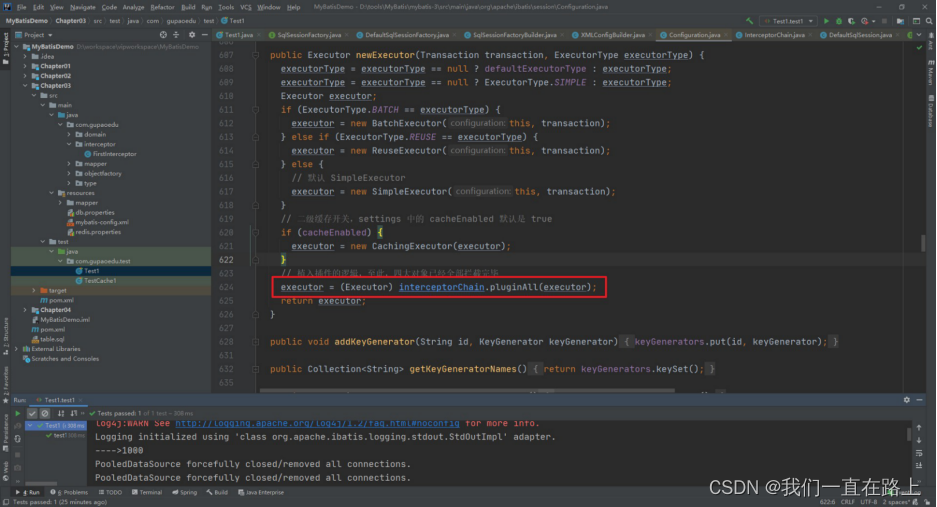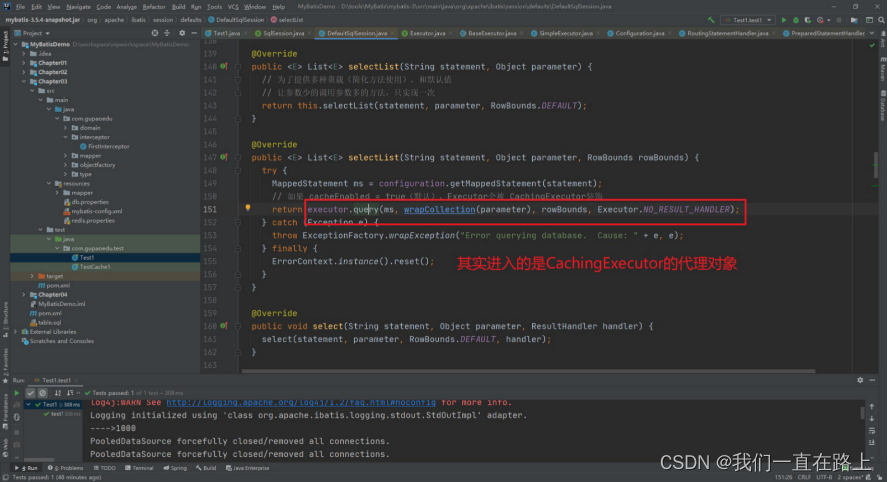1.自定义插件
1.1创建Interceptor实现类
我们创建的拦截器必须要实现Interceptor接口,Interceptor接口的定义为
public interface Interceptor {
// 执行拦截逻辑的方法 111
Object intercept(Invocation invocation) throws Throwable;
// 决定是否触发 intercept()方法
default Object plugin(Object target) {
return Plugin.wrap(target, this);
}
// 根据配置 初始化 Intercept 对象
default void setProperties(Properties properties) {
// NOP
}
}
在MyBatis中Interceptor允许拦截的内容是
- Executor (update, query, flushStatements, commit, rollback, getTransaction, close, isClosed)
- ParameterHandler (getParameterObject, setParameters)
- ResultSetHandler (handleResultSets, handleOutputParameters)
- StatementHandler (prepare, parameterize, batch, update, query)
@Intercepts({
@Signature(
type = Executor.class // 需要拦截的类型
,method = "query" // 需要拦截的方法
// args 中指定 被拦截方法的 参数列表
,args={MappedStatement.class,Object.class, RowBounds.class, ResultHandler.class}
),
@Signature(
type = Executor.class
,method = "close"
,args = {boolean.class}
)
})
public class TestInterceptor implements Interceptor {
@Override
public Object intercept(Invocation invocation) throws Throwable {
System.out.println("TestInterceptor 拦截之前 ");
invocation.proceed();
System.out.println("TestInterceptor 拦截之后 ");
}
@Override
public Object plugin(Object target) {
return Plugin.wrap(target,this);
}
@Override
public void setProperties(Properties properties) {
}
}
1.2 配置拦截器
创建好自定义的拦截器后,我们需要在全局配置文件中添加自定义插件的注册
<plugin interceptor="com.kangping.intercepter.TestInterceptor">
<property name="testProp" value="1000"/>
</plugin>
2.插件实现原理
2.1初始化操作
首先我们来看下在全局配置文件加载解析的时候做了什么操作。

进入方法内部可以看到具体的解析操作
private void pluginElement(XNode parent) throws Exception {
if (parent != null) {
for (XNode child : parent.getChildren()) {
// 获取<plugin> 节点的 interceptor 属性的值
String interceptor = child.getStringAttribute("interceptor");
// 获取<plugin> 下的所有的properties子节点
Properties properties = child.getChildrenAsProperties();
// 获取 Interceptor 对象
Interceptor interceptorInstance = (Interceptor) resolveClass(interceptor).getDeclaredConstructor().newInstance();
// 设置 interceptor的 属性
interceptorInstance.setProperties(properties);
// Configuration中记录 Interceptor
configuration.addInterceptor(interceptorInstance);
}
}
}
该方法用来解析全局配置文件中的plugins标签,然后对应的创建Interceptor对象,并且封装对应的 属性信息。最后调用了Configuration对象中的方法。
进入到configuration.addInterceptor(interceptorInstance)
public void addInterceptor(Interceptor interceptor) {
interceptorChain.addInterceptor(interceptor);
}
通过这个代码我们发现我们自定义的拦截器最终是保存在了InterceptorChain这个对象中。而InterceptorChain的定义为
/**
* InterceptorChain 记录所有的拦截器
* @author Clinton Begin
*/
public class InterceptorChain {
// 保存所有的 Interceptor 也就我所有的插件是保存在 Interceptors 这个List集合中的
private final List<Interceptor> interceptors = new ArrayList<>();
//
public Object pluginAll(Object target) {
for (Interceptor interceptor : interceptors) { // 获取拦截器链中的所有拦截器
target = interceptor.plugin(target); // 创建对应的拦截器的代理对象
}
return target;
}
public void addInterceptor(Interceptor interceptor) {
interceptors.add(interceptor);
}
public List<Interceptor> getInterceptors() {
return Collections.unmodifiableList(interceptors);
}
}
2.2 如何创建代理对象
在解析的时候创建了对应的Interceptor对象,并保存在了InterceptorChain中,那么这个拦截器是如 何和对应的目标对象进行关联的呢?首先拦截器可以拦截的对象是
Executor,ParameterHandler,ResultSetHandler,StatementHandler.那么我们来看下这四个对象在创建的时候又什么要注意的
2.2.1Executor

我们可以看到Executor在装饰完二级缓存后会通过pluginAll来创建Executor的代理对象。
public Object pluginAll(Object target) {
for (Interceptor interceptor : interceptors) { // 获取拦截器链中的所有拦截器
target = interceptor.plugin(target); // 创建对应的拦截器的代理对象
}
return target;
}
进入plugin方法中,我们会进入到
default Object plugin(Object target) {
return Plugin.wrap(target, this);
}
然后进入到MyBatis给我们提供的Plugin工具类的实现 wrap方法中。
/**
* 创建目标对象的代理对象
* 目标对象 Executor ParameterHandler ResultSetHandler StatementHandler
* @param target 目标对象
* @param interceptor 拦截器
* @return
*/
public static Object wrap(Object target, Interceptor interceptor) {
// 获取用户自定义 Interceptor中@Signature注解的信息
// getSignatureMap 负责处理@Signature 注解
Map<Class<?>, Set<Method>> signatureMap = getSignatureMap(interceptor);
// 获取目标类型
Class<?> type = target.getClass();
// 获取目标类型 实现的所有的接口
Class<?>[] interfaces = getAllInterfaces(type, signatureMap);
// 如果目标类型有实现的接口 就创建代理对象
if (interfaces.length > 0) {
return Proxy.newProxyInstance(
type.getClassLoader(),
interfaces,
new Plugin(target, interceptor, signatureMap));
}
// 否则原封不动的返回目标对象
return target;
}
Plugin中的各个方法的作用
/**
* @author Clinton Begin
*/
public class Plugin implements InvocationHandler {
private final Object target; // 目标对象
private final Interceptor interceptor; // 拦截器
private final Map<Class<?>, Set<Method>> signatureMap; // 记录 @Signature 注解的信息
private Plugin(Object target, Interceptor interceptor, Map<Class<?>, Set<Method>> signatureMap) {
this.target = target;
this.interceptor = interceptor;
this.signatureMap = signatureMap;
}
/**
* 创建目标对象的代理对象
* 目标对象 Executor ParameterHandler ResultSetHandler StatementHandler
* @param target 目标对象
* @param interceptor 拦截器
* @return
*/
public static Object wrap(Object target, Interceptor interceptor) {
// 获取用户自定义 Interceptor中@Signature注解的信息
// getSignatureMap 负责处理@Signature 注解
Map<Class<?>, Set<Method>> signatureMap = getSignatureMap(interceptor);
// 获取目标类型
Class<?> type = target.getClass();
// 获取目标类型 实现的所有的接口
Class<?>[] interfaces = getAllInterfaces(type, signatureMap);
// 如果目标类型有实现的接口 就创建代理对象
if (interfaces.length > 0) {
return Proxy.newProxyInstance(
type.getClassLoader(),
interfaces,
new Plugin(target, interceptor, signatureMap));
}
// 否则原封不动的返回目标对象
return target;
}
/**
* 代理对象方法被调用时执行的代码
* @param proxy
* @param method
* @param args
* @return
* @throws Throwable
*/
@Override
public Object invoke(Object proxy, Method method, Object[] args) throws Throwable {
try {
// 获取当前方法所在类或接口中,可被当前Interceptor拦截的方法
Set<Method> methods = signatureMap.get(method.getDeclaringClass());
if (methods != null && methods.contains(method)) {
// 当前调用的方法需要被拦截 执行拦截操作
return interceptor.intercept(new Invocation(target, method, args));
}
// 不需要拦截 则调用 目标对象中的方法
return method.invoke(target, args);
} catch (Exception e) {
throw ExceptionUtil.unwrapThrowable(e);
}
}
private static Map<Class<?>, Set<Method>> getSignatureMap(Interceptor interceptor) {
Intercepts interceptsAnnotation = interceptor.getClass().getAnnotation(Intercepts.class);
// issue #251
if (interceptsAnnotation == null) {
throw new PluginException("No @Intercepts annotation was found in interceptor " + interceptor.getClass().getName());
}
Signature[] sigs = interceptsAnnotation.value();
Map<Class<?>, Set<Method>> signatureMap = new HashMap<>();
for (Signature sig : sigs) {
Set<Method> methods = signatureMap.computeIfAbsent(sig.type(), k -> new HashSet<>());
try {
Method method = sig.type().getMethod(sig.method(), sig.args());
methods.add(method);
} catch (NoSuchMethodException e) {
throw new PluginException("Could not find method on " + sig.type() + " named " + sig.method() + ". Cause: " + e, e);
}
}
return signatureMap;
}
private static Class<?>[] getAllInterfaces(Class<?> type, Map<Class<?>, Set<Method>> signatureMap) {
Set<Class<?>> interfaces = new HashSet<>();
while (type != null) {
for (Class<?> c : type.getInterfaces()) {
if (signatureMap.containsKey(c)) {
interfaces.add(c);
}
}
type = type.getSuperclass();
}
return interfaces.toArray(new Class<?>[interfaces.size()]);
}
}
2.2.2 StatementHandler
在获取StatementHandler的方法中
public <E> List<E> doQuery(MappedStatement ms, Object parameter, RowBounds rowBounds, ResultHandler resultHandler, BoundSql boundSql) throws SQLException {
Statement stmt = null;
try {
Configuration configuration = ms.getConfiguration();
// 注意,已经来到SQL处理的关键对象 StatementHandler >>
StatementHandler handler = configuration.newStatementHandler(wrapper, ms, parameter, rowBounds, resultHandler, boundSql);
// 获取一个 Statement对象
stmt = prepareStatement(handler, ms.getStatementLog());
// 执行查询
return handler.query(stmt, resultHandler);
} finally {
// 用完就关闭
closeStatement(stmt);
}
}
在进入newStatementHandler方法
public StatementHandler newStatementHandler(Executor executor, MappedStatement mappedStatement, Object parameterObject, RowBounds rowBounds, ResultHandler resultHandler, BoundSql boundSql) {
StatementHandler statementHandler = new RoutingStatementHandler(executor, mappedStatement, parameterObject, rowBounds, resultHandler, boundSql);
// 植入插件逻辑(返回代理对象)
statementHandler = (StatementHandler) interceptorChain.pluginAll(statementHandler);
return statementHandler;
}
可以看到statementHandler的代理对象
2.2.3 ParameterHandler
在上面步骤的RoutingStatementHandler方法中,我们来看看
public RoutingStatementHandler(Executor executor, MappedStatement ms, Object parameter, RowBounds rowBounds, ResultHandler resultHandler, BoundSql boundSql) {
// StatementType 是怎么来的? 增删改查标签中的 statementType="PREPARED",默认值 PREPARED
switch (ms.getStatementType()) {
case STATEMENT:
delegate = new SimpleStatementHandler(executor, ms, parameter, rowBounds, resultHandler, boundSql);
break;
case PREPARED:
// 创建 StatementHandler 的时候做了什么? >>
delegate = new PreparedStatementHandler(executor, ms, parameter, rowBounds, resultHandler, boundSql);
break;
case CALLABLE:
delegate = new CallableStatementHandler(executor, ms, parameter, rowBounds, resultHandler, boundSql);
break;
default:
throw new ExecutorException("Unknown statement type: " + ms.getStatementType());
}
}
在newParameterHandler的步骤我们可以发现代理对象的创建
public ParameterHandler newParameterHandler(MappedStatement mappedStatement, Object parameterObject, BoundSql boundSql) {
ParameterHandler parameterHandler = mappedStatement.getLang().createParameterHandler(mappedStatement, parameterObject, boundSql);
// 植入插件逻辑(返回代理对象)
parameterHandler = (ParameterHandler) interceptorChain.pluginAll(parameterHandler);
return parameterHandler;
}
2.2.4 ResultSetHandler
在上面的newResultSetHandler()方法中,也可以看到ResultSetHander的代理对象
public ResultSetHandler newResultSetHandler(Executor executor, MappedStatement mappedStatement, RowBounds rowBounds, ParameterHandler parameterHandler,
ResultHandler resultHandler, BoundSql boundSql) {
ResultSetHandler resultSetHandler = new DefaultResultSetHandler(executor, mappedStatement, parameterHandler, resultHandler, boundSql, rowBounds);
// 植入插件逻辑(返回代理对象)
resultSetHandler = (ResultSetHandler) interceptorChain.pluginAll(resultSetHandler);
return resultSetHandler;
}
2.3 执行流程
以Executor的query方法为例,当查询请求到来的时候,Executor的代理对象是如何处理拦截请求的 呢?我们来看下。当请求到了executor.query方法的时候

然后会执行Plugin的invoke方法
@Override
public Object invoke(Object proxy, Method method, Object[] args) throws Throwable {
try {
// 获取当前方法所在类或接口中,可被当前Interceptor拦截的方法
Set<Method> methods = signatureMap.get(method.getDeclaringClass());
if (methods != null && methods.contains(method)) {
// 当前调用的方法需要被拦截 执行拦截操作
return interceptor.intercept(new Invocation(target, method, args));
}
// 不需要拦截 则调用 目标对象中的方法
return method.invoke(target, args);
} catch (Exception e) {
throw ExceptionUtil.unwrapThrowable(e);
}
}
然后进入interceptor.intercept 会进入我们自定义的 TestInterceptor对象中
@Override
public Object intercept(Invocation invocation) throws Throwable {
System.out.println("TestInterceptor 拦截之前 ");
invocation.proceed();
System.out.println("TestInterceptor 拦截之后 ");
}
2.4 多拦截器
如果我们有多个自定义的拦截器,那么他的执行流程是怎么样的呢?比如我们创建了两个Interceptor 都是用来拦截 Executor 的query方法,一个是用来执行逻辑A 一个是用来执行逻辑B的。单个拦截器的执行流程

如果说对象被代理了多次,这里会继续调用下一个插件的逻辑,再走一次Plugin的invoke()方法。这里我们需要关注一下有多个插件的时候的运行顺序。
配置的顺序和执行的顺序是相反的。InterceptorChain的List是按照插件从上往下的顺序解析、添加 的。
而创建代理的时候也是按照list的顺序代理。执行的时候当然是从最后代理的对象开始。

这个我们可以通过实际的案例来得到验证,最后来总结下Interceptor的相关对象的作用
| 对象 | 作用 |
|---|---|
| Interceptor | 自定义插件需要实现接口,实现4个方法 |
| InterceptChain | 配置的插件解析后会保存在Configuration的InterceptChain中 |
| Plugin | 触发管理类,还可以用来创建代理对象 |
| Invocation | 对被代理类进行包装,可以调用proceed()调用到被拦截的方法 |






















 986
986











 被折叠的 条评论
为什么被折叠?
被折叠的 条评论
为什么被折叠?








